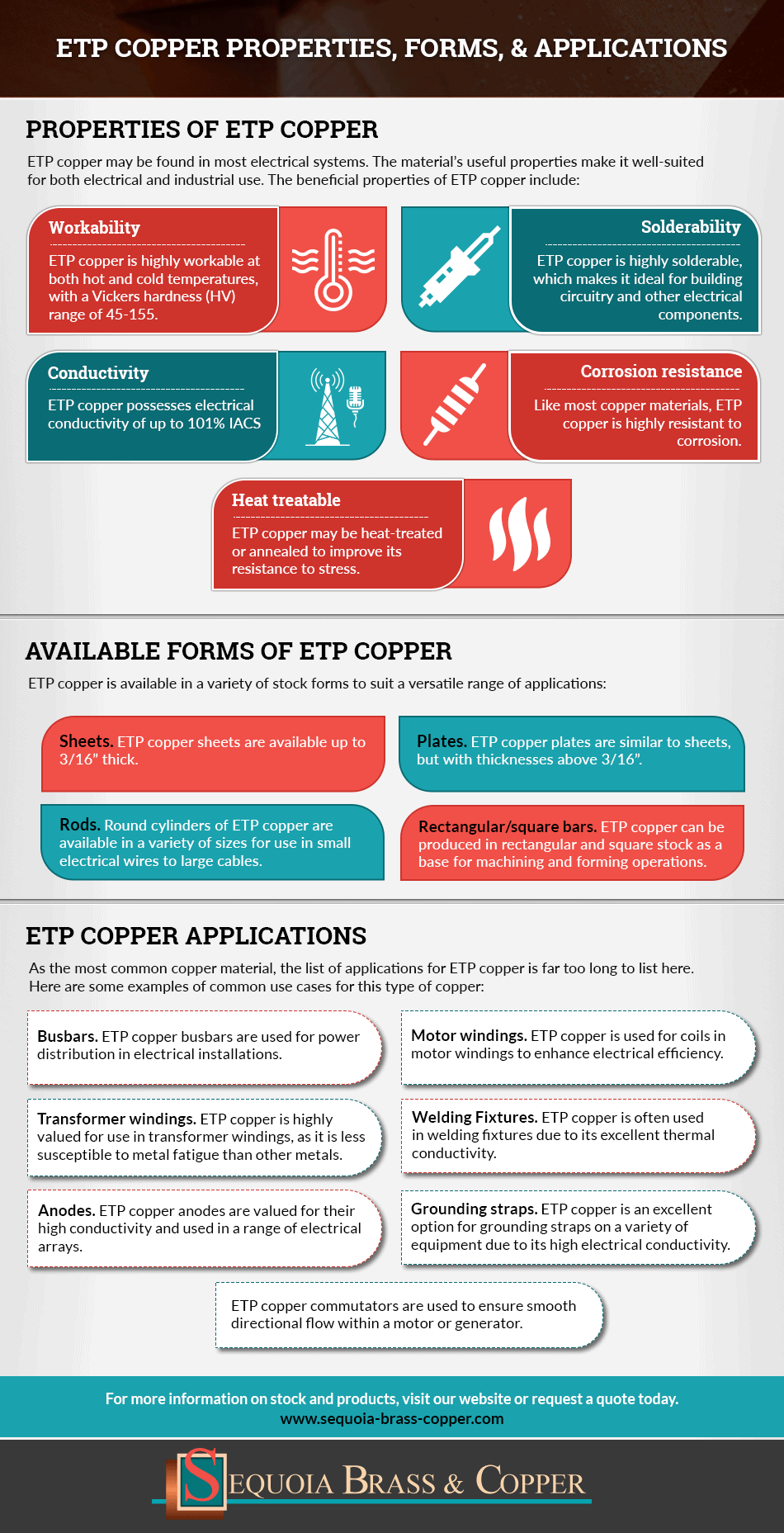The most common variety of copper available on the market, electrolytic tough pitch (ETP) copper is highly conductive, making it an ideal material for delivering electrical current for a wide range of applications. Also known as C11000 copper, ETP copper is considered to be commercially pure, with a minimum copper purity level of 99.9%.
Properties of ETP Copper (C11000 Copper)
ETP copper may be found in most electrical systems. The material’s useful properties make it well-suited for both electrical and industrial use. C11000 copper’s unique qualities include:
- Workability and formability. ETP copper is highly workable at both hot and cold temperatures, with a Vickers hardness (HV) range of 45 to 155.
- Solderability. ETP copper is highly solderable, which makes it ideal for building circuitry and other electrical components.
- Conductivity. In addition to offering high thermal conductivity, ETP copper possesses electrical conductivity of up to 101% IACS.
- Corrosion resistance. Like most copper materials, ETP copper is highly resistant to corrosion.
- Compatibility with heat treatments. ETP copper may be heat-treated or annealed to improve its resistance to stress.
- Recyclability. The material is also a sustainable option as it’s recyclable.
- Hydrogen embrittlement susceptibility. When hydrogen is present, ETP copper may become brittle and experience damage or fracturing.
Getting back to conductivity, while it’s electrolytically refined, ETP copper’s oxygen content remains between 300 to 400 ppm. This maximizes electrical conductivity, tying solute up as oxide and forming copper oxide. Solid copper’s oxygen solubility is minimal in most thermal conditions, causing Cu2O to develop. Solubility increases as the material approaches its melting range, at which point it can achieve a value of 0.0075%.
Should the solid copper rapidly cool, however, it may cause an unstable volume of oxygen within the solution, which is called supersaturation, and negatively impact various copper manufacturing phases. In C11000 copper, oxygen serves as an alloying element for effectively eliminating solute elements. If left to remain in the solid solution, these solutes would result in raised resistivity, whereas having oxides present doesn’t affect the copper’s electrical conductivity.
Available Forms of C11000 Copper
Depending upon the needs of your project, you have the option to choose ETP copper from various stock forms. These forms include:
- Copper sheets. SBC offers Cu-ETP copper sheets up to 3/16 of an inch thick.
- Copper plates. While similar to our sheets, our copper plates are available in thicknesses greater than 3/16 of an inch.
- Copper rods. Our team provides round ETP copper cylinders in various sizes for applications ranging from large cables to small electrical wires.
- Square and rectangular copper bars. We also carry square and rectangular ETP copper stock applicable for forming and machining projects.
Electrolytic Copper Applications
As the most common copper material, the list of applications for ETP copper is far too long to list here. However, here are some examples of common use cases for this type of copper:
- Busbars. ETP copper busbars are used for power distribution in electrical installations.
- Motor windings. ETP copper is used for coils in motor windings to enhance electrical efficiency.
- Transformer windings. This copper variety is highly valued for use in foil-wound transformers within electrical transmissions and panels as it’s less susceptible to metal fatigue than other metals.
- Welding fixtures. ETP copper is often used in welding fixtures due to its excellent thermal conductivity.
- Anodes. ETP copper anodes are valued for their high conductivity and are used in a range of electrical arrays.
- Grounding straps. The metal is an excellent option for grounding straps on a variety of equipment due to its high electrical conductivity.
- Commutators. These ETP copper components ensure smooth directional flow within a motor or generator.
- Additional electrical components. In addition to the items above, ETP copper may also be involved in the manufacture of the following: electrical conductors, contacts, switch parts, terminals, shielding tapes, and cable wraps.
- Industrial products. Finally, ETP copper is good for industrial products like punched or stamped metal components, heat sinks, and chlorine battery caps.
ETP Copper From Sequoia Brass & Copper
At Sequoia Brass & Copper, we guarantee the highest quality C11000 electrolytic copper on the market. We are pleased to provide only the purest metal sheets, plates, and bars for use by myriad industries. Our extensive selection of materials also includes an expansive list of copper, brass, and bronze, with numerous alloys, shapes, and sizes to meet the needs of every application.
Since 1983, Sequoia Brass & Copper has been a preferred industry provider of superior metal products. All of our materials are cut and shaped on demand in our ISO 9001:2015-certified facility in Hayward, California. Our extensive quality assurance procedures ensure that all of our products are cut to exceptionally tight tolerances. Our convenient location and sizable warehouse allow us to provide competitive pricing and shipping rates on all products.
For more information on stock and products, visit our website, view our copper catalog, or request a quote today.

